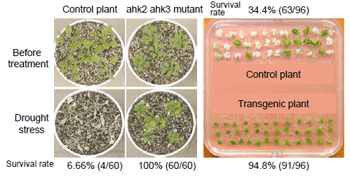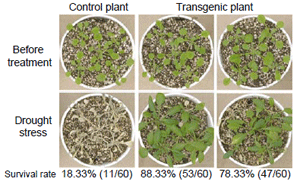An Arabidopsis histidine kinase AHK1 functions as an osmosensor and its overexpression improves plant drought-stress tolerance
Description
Plants are constantly exposed to environmental stresses that frequently impose constraints on their growth and productivity. But, plant cells have developed elaborate and sensitive protection systems which enable them to rapidly signal, respond and properly adapt to various stresses, including drought and high salinity. Phosphorylation, which is catalyzed by protein kinases, is a key mechanism for intracellular signal transduction in both eukaryotic and prokaryotic cells. In yeast, a histidine kinase SLN1 functions as an osmosensor that can sense and transduce a signal of external osmolarity to downstream targets. Arabidopsis contains eleven receptor histidine kinases and among them, AHK1, AHK2 and AHK3 were shown to be stress inducible, suggesting their roles in the regulation of plant responses to abiotic stress. Overexpression of an Arabidopsis histidine kinase AHK1 in yeast sln1 deletion mutants enables the yeast mutant to grow normally under high salinity conditions, suggesting that the histidine kinase AHK1 can function as an osmosensor. Then, we introduced the AHK2 and AHK3 cDNAs into the sln1 mutant and found that these 2 kinases can also complement the SLN1 function, suggesting the functional importance of these histidine kinases for the efficient sensing of environmental signals.
To understand the in planta role of the stress-responsive histidine kinases in osmotic stress, we used both gain-of-function and loss-of-function genetic approaches. Multiple mutants of ahk1, ahk2 and ahk3 were constructed to elucidate the function of these kinases in plant growth and development. Phenotypic analyses for ahk1 knockdown mutants suggested that these mutants are not affected in growth or morphology under normal conditions. However, under drought stress condition, fewer ahk1 plants survived than WT plants, indicating a clear drought sensitivity for ahk1 mutant. Moreover, the ahk1 mutants were more sensitive to high-salinity stress than WT. Then, we compared the level of drought and salt stress tolerance of the ahk2 and ahk3 mutants, as well as the ahk2 ahk3 double mutant, to WT plants. Different from the ahk1 mutant, the results showed a strong drought and salinity tolerance for both ahk2 and ahk3 mutants. The ahk2 ahk3 double mutant was even more tolerant to drought and salt stresses than the respective single ones, suggesting a combinatory function of AHK2 and AHK3 in osmotic stress signaling (Fig.1).
We performed microarray analyses to understand the diversity of these histidine kinases. Under normal conditions, many stress-responsive genes, including genes for stress-related transcription factors (TFs) ANAC055 and ATMYC2, were upregulated in the ahk2 ahk3 double mutant. Importantly, overexpression of these TF genes significantly improves drought stress tolerance in Arabidopsis plants. These data indicate that AHK2 and AHK3 function as negative regulators in stress signaling. In contrast, many stress-responsive genes, including AREB1, DREB2 and ANAC TFs, were downregulated in the ahk1 mutant under dehydration stress, which indicates that AHK1 functions as a positive regulator in stress signaling. Therefore, we generated Arabidopsis transgenic plants, in which AHK1 was overexpressed by using its own promoter. We obtained two stable lines showing higher dehydration-induced AHK1 transcript. Under normal conditions, these transgenic plants (Fig.2) displayed similar morphological phenotypes with regards to the size of rosette leaves and inflorescences. The drought tolerance of the transgenic plants was increased as compared with that of the control plants. These data suggest that the AHK1 gene can be used to develop crops that are tolerant to drought stress.
Figure, table
-
Fig.1 Drought stress tolerance (left) and salt stress tolerance (right) of ahk2 ahk3 double mutants.
Arabidopsis plants lacking AHK2 and AHK3 showed improved tolerance to drought and high salinity, but exhibited growth retardation on the other hand. -
Fig.2. Drought stress tolerance of transgenic Arabidopsis overexpressing AHK1.
Transgenic Arabidopsis grew as well as the control plants under normal conditions, and on the other hand, showed improved tolerance to drought stress.
- Affiliation
-
Japan International Research Center for Agricultural Sciences Biological Resources Division
- Classification
-
Technical A
- Term of research
-
FY2007(FY2004~2011)
- Responsible researcher
-
TRAN Lam-Son Phan ( Biological Resources Division )
QIN Feng ( Biological Resources Division )
MARUYAMA Kyonoshin ( Biological Resources Division )
YAMAGUCHI-SHINOZAKI Kazuko ( Biological Resources Division )
- ほか
- Publication, etc.
-
Tran, L.-S. P., Urao, T., Qin, F., Maruyama, K., Kakimoto, T., Shinozaki, K., and Yamaguchi-Shinozaki, K. (2007) Functional analysis of AHK1/ATHK1 and cytokinin receptor histidine kinases in response to abscisic acid, drought and salt stresses in Arabidopsis. Proc. Natl. Acad. Sci. USA. 104,20623-20628
Shinozaki, K. and Yamaguchi-Shinozaki, K. (2007) Gene networks involved in drought stress response and tolerance. J. Exp Bot. 58, 221-227.
- Japanese PDF
-
2007_seikajouhou_A4_ja_Part7.pdf693.69 KB


